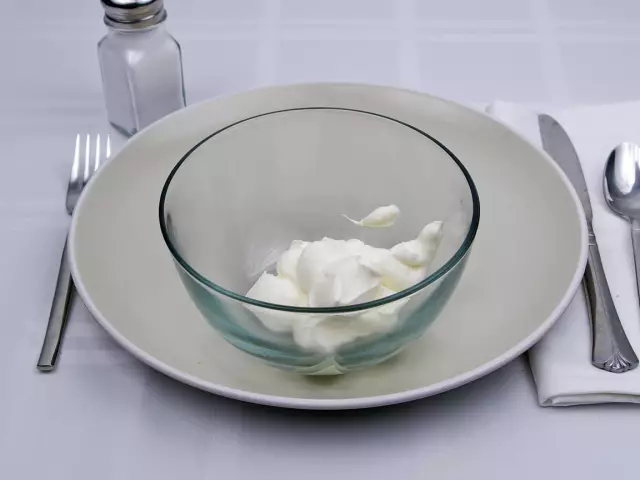- Author Rachel Wainwright [email protected].
- Public 2023-12-15 07:39.
- Last modified 2025-11-02 20:14.
Lamikon
Lamikon: instructions for use and reviews
- 1. Release form and composition
- 2. Pharmacological properties
- 3. Indications for use
- 4. Contraindications
- 5. Method of application and dosage
- 6. Side effects
- 7. Overdose
- 8. Special instructions
- 9. Application during pregnancy and lactation
- 10. Use in childhood
- 11. In case of impaired renal function
- 12. Drug interactions
- 13. Analogs
- 14. Terms and conditions of storage
- 15. Terms of dispensing from pharmacies
- 16. Reviews
- 17. Price in pharmacies
Latin name: Lamicon
ATX code: D01AE15
Active ingredient: terbinafine (terbinafine)
Producer: Farmak, PJSC (Ukraine)
Description and photo update: 2019-26-08

Lamikon is an antifungal drug for local and systemic use.
Release form and composition
Lamikon is available in the following dosage forms:
- Tablets (7 pcs. In blisters, 2 blisters in a cardboard box);
- Cream (15 g in tubes, 1 tube in a cardboard box);
- Skin spray (25 g in vials with a dosing pump, 1 vial in a cardboard box).
The composition of 1 tablet includes:
- Active ingredient: terbinafine hydrochloride - 250 mg (in terms of terbinafine 100% anhydrous substance);
- Auxiliary components: microcrystalline cellulose, corn starch, anhydrous colloidal silicon dioxide, sodium starch glycolate (type A), hydroxypropyl methylcellulose, magnesium stearate.
The 100 mg cream contains:
- Active ingredient: terbinafine hydrochloride - 1 mg (in terms of terbinafine 100% anhydrous substance);
- Auxiliary components: phenylethyl alcohol, soft white paraffin, mineral oil, cetostearyl alcohol, polyethylene glycol (macrogol) 20 cetostearyl ether, propylene glycol, poloxamer 407, sodium hydroxide, purified water.
The composition of 100 mg cutaneous spray includes:
- Active ingredient: terbinafine hydrochloride - 1 mg (in terms of terbinafine 100% anhydrous substance);
- Auxiliary components: benzoic acid (E 210), polyethylene glycol (macrogol) 20 cetostearyl ether, propylene glycol, poloxamer 407, edetate disodium, water for injection.
Pharmacological properties
Pharmacodynamics
The active ingredient in Lamicon, terbinafine, is an allylamine. The substance has a wide spectrum of action and is highly active against infections of the skin, nails and hair, which are caused by the following dermatophytes: Microsporum (including Microsporum canis), Trichophyton (including T. tonsurans, T. verrucosum, T. rubrum, T. mentagrophytes, T. Violaceum), Epidermophyton floccosum. Terbinafine is also effective against yeast-like fungi of the genus Candida (including Candida albicans) and Pityrosporum.
When used in low concentrations, the substance has a fungicidal effect against dermatophytes, molds and some dimorphic fungi. Activity against yeast-like fungi can be fungicidal or fungistatic (depending on their type).
Terbinafine has a specific stimulating effect on the early stage of sterol synthesis in the fungal cell. This causes a lack of ergosterol and intracellular accumulation of squalene, which causes the death of the fungal cell. The action of the substance is due to the inhibition of the enzyme squalene epoxidase in the cell membrane. This enzyme does not belong to the cytochrome P 450 system.
When taken orally, Lamikon accumulates in the skin, nails and hair in concentrations that provide a fungicidal effect.
Pharmacokinetics
Pills
After oral administration, terbinafine is well absorbed (> 70% based on metabolism after the first passage through the liver). The absolute bioavailability of the substance is approximately 50%.
The average value of peak plasma concentrations in the blood after taking a single dose of 250 mg terbinafine is 0.001-3 mg / ml, the time to reach is 1.5 hours. Under the condition of a stable state, compared with a single dose, the peak concentration of terbinafine is on average 25% higher, and the area under the blood plasma curve increases by 2.3 times. The estimated effective half-life is approximately 30 hours. Food intake has little effect on the bioavailability of terbinafine, dose adjustment is not required.
Terbinafine characterizes active binding to plasma proteins (99%). The substance quickly diffuses through the dermis and concentrates in the lipophilic stratum corneum. Terbinafine is also secreted by the sebaceous glands, reaching high concentrations in the skin, hair and hair follicles. It has been proven that during the first weeks after the start of therapy, the substance is distributed in the nail plates.
Metabolism occurs with the participation of at least 7 cytochrome P 450 isoenzymes, the main of which are CYP2C8, CYP2C9, CYP1A2, CYP3A4, CYP2C19. Changes in the equilibrium concentration of terbinafine in plasma, depending on age, have not been identified, but with impaired renal or hepatic function, the rate of excretion of the drug may slow down, which leads to an increase in the concentration of terbinafine in the blood.
As a result of biotransformation of terbinafine, metabolites are formed that do not have an antifungal effect and are excreted mainly in the urine.
According to pharmacokinetic studies of a single dose in patients with renal insufficiency (with creatinine clearance <50 ml / min) or with pre-existing liver disease, terbinafine clearance may decrease by about 50%.
Skin cream and spray
The absorption of terbinafine when applied externally is up to 5% of the dose, therefore the absorption of the substance into the systemic circulation is negligible.
Terbinafine begins to act quickly, the effectiveness is manifested with short-term treatment (7 days). After 7 days of therapy, terbinafine concentrations that exceed those required for fungicidal action are noted in the stratum corneum of the epidermis, at least for a week after Lamikon is discontinued.
Indications for use
Lamikon tablets are prescribed for the treatment of the following diseases:
- Onychomycosis (fungal nail infections) caused by dermatophyte fungi;
- Mycoses of the scalp;
- Fungal infections of the skin (trichophytosis of the perineum, smooth skin, dermatomycosis and yeast infections of the skin caused by fungi of the genus Candida), in cases where the localization of the lesions, the prevalence or severity of the infection determine the advisability of oral administration of Lamicon.
Outwardly, Lamikon cream and spray are prescribed in the presence of the following indications:
- Fungal skin infections caused by dermatophytes such as Trichophyton (eg T. mentagrophytes, T. rubrum, T. Violaceum, T. verrucosum), Epidermophytonfloccosum, and Microsporum canis (eg, foot dermatophytosis);
- Dermatophytosis of the trunk (ringworm);
- Inguinal dermatophytosis ("jockey's itch");
- Skin candidiasis caused by fungi of the genus Candida, usually Candida albicans;
- Versicolor versicolor (Pityriasis versicolor) caused by Pityrosporum orbiculare.
Contraindications
According to the instructions, Lamikon in all dosage forms is contraindicated for use in the presence of hypersensitivity to the components of the drug.
For children, the drug is prescribed:
- Tablets: from 6 years old with a body weight of at least 20 kg;
- Cream: from 12 years old.
Skin spray is used from 18 years of age (the safety and efficacy of using the drug in this form in patients under 18 years of age have not been established).
There is no experience with the use of Lamicon tablets with reduced renal function (in patients with creatinine clearance up to 50 ml / min or serum creatinine above 300 μmol / l), therefore, therapy in this group of patients is not recommended.
Pregnant women can use any of the forms of Lamicon only after consulting a doctor who will assess the benefit / risk ratio for the health of the mother and the fetus. It is not recommended to use the drug for lactating women.
Instructions for the use of Lamikon: method and dosage
Lamikon tablets are taken orally.
The duration of therapy is determined by the nature and severity of the disease.
As a rule, the following dosage regimens of Lamicon are used:
- Children from 6 years old with a body weight of 20-40 kg: 125 mg once a day;
- Adults and children weighing 40 kg or more: 250 mg once a day.
Recommended duration of treatment for skin infections:
- Dermatomycosis of the feet: 2-6 weeks;
- Skin candidiasis: 2-4 weeks;
- Trichophytosis of the perineum, smooth skin: 2-4 weeks.
The complete disappearance of signs of infection and related complaints usually occurs only a few weeks after mycological recovery.
In case of fungal infections of the scalp, Lamikon is recommended to be used for 4 weeks (the disease is observed mainly in children).
With onychomycosis, the following duration of drug use is recommended:
- Onychomycosis on the hands - 6 weeks;
- Onychomycosis on the legs - 12 weeks.
Some patients with reduced nail growth rates may require longer treatment.
The optimal clinical effect for fungal nail infections is observed several months after the mycological recovery and discontinuation of Lamicon, which corresponds to the period of time required for a healthy nail to grow back.
Depending on the disease, Lamikon cream and spray are applied 1-2 times a day to the affected skin areas, thoroughly cleaned and dried beforehand, as well as to the adjacent areas. After application, the cream should be lightly rubbed in.
In case of infections accompanied by diaper rash (in the interdigital area, under the mammary glands, between the buttocks and in the groin area), the place of application of Lamikon cream, especially at night, can be covered with gauze.
The scheme of application of Lamicon is determined by the indications:
- Inguinal dermatophytosis, interdigital dermatophytosis of the feet, dermatophytosis of the trunk: once a day, course - 1 week;
- Skin candidiasis: 1-2 times a day, course - 1 week;
- Squamous-hyperkeratotic dermatophytosis of the feet ("moccasin foot"): 2 times a day, course - 2 weeks;
- Versicolor versicolor: 1-2 times a day, course - 2 weeks (cream); 2 times a day, course - 1 week (skin spray).
Elderly patients should not adjust the dosage regimen.
Symptoms usually improve over several days. Irregular use of Lamicon or premature discontinuation of therapy can lead to the development of relapse.
If there are no signs of improvement within 2 weeks of treatment, you need to see a doctor.
Side effects
As a rule, Lamikon is well tolerated.
When the drug is taken orally, side effects are usually mild or mild and are of short duration. During therapy, the following disorders may develop (≥10% - very often; from ≥1% to 10% - often; from ≥0.1% to <1% - infrequently; from ≥0.01% to <0.1% - rarely; from <0.01%, including single messages - very rare):
- Nervous system: often - headache; rarely - taste disturbance (disappears on its own, as a rule, after stopping treatment for several weeks); very rarely - dizziness, hypesthesia, paresthesia;
- Hepatobiliary system: rarely - an increase in the level of liver enzymes, hepatobiliary dysfunction (mainly of cholestatic origin); there are isolated reports of the development of severe functional disorders of the liver, including jaundice, hepatitis, cholestasis;
- Immune system: very rarely - anaphylactoid reactions (including angioedema), systemic and cutaneous manifestations of lupus erythematosus, Stevens-Johnson syndrome, photosensitivity, toxic epidermal necrolysis (Lyell's syndrome);
- Gastrointestinal tract: very often - dyspepsia, feeling of fullness in the stomach, loss of appetite, diarrhea, nausea, slight pain in the abdomen;
- Musculoskeletal system: very often - myalgia, arthralgia;
- Skin and subcutaneous tissue: very often - mild skin reactions (urticaria, rash); very rarely - acute generalized exanthematous pustulosis, exacerbation of psoriasis or psoriasis-like rashes, hair loss (a causal relationship has not been proven);
- Blood and lymphatic system: very rarely - agranulocytosis, neutropenia, pancytopenia, thrombocytopenia;
- General disorders: very rarely - fatigue.
When Lamikon is applied topically, at the site of application, such disorders as burning or peeling of the skin, itching, erythema, pigmentation disorders, crusting and others can develop. These minor side effects must be distinguished from sporadic reports of hypersensitivity reactions, including rashes. In these cases, discontinuation of therapy is required.
Accidental eye contact with the drug can cause irritation. In rare cases, an exacerbation of a latent fungal infection is possible.
With external use of Lamikon, the following side effects may develop:
- Immune system: hypersensitivity reactions, including urticaria;
- Skin and connective tissue: eczema, skin damage, itching, contact dermatitis, dry skin feeling, rash;
- Organ of vision: eye irritation;
- General disorders and reactions at the site of application: pain and irritation at the site of application, exacerbation of symptoms of the disease.
Overdose
There are reports of several cases of overdose (oral administration of up to 5 g of terbinafine).
The main symptoms: vomiting, nausea, epigastric pain, headache, dizziness.
When applied topically / externally, terbinafine has a low systemic absorption, so the likelihood of an overdose of Lamicone during cream and spray therapy is minimal. If you accidentally swallow more cream / spray, you may develop side reactions similar to those of an overdose of tablets.
Therapy: gastric lavage, the use of activated carbon, if necessary, symptomatic treatment is carried out.
special instructions
Lamikon in tablet form is not recommended for patients with active or chronic liver damage. Before starting therapy, it is necessary to assess the patient's condition and pre-existing liver diseases.
If symptoms such as persistent nausea of unknown etiology, anorexia, fatigue, vomiting, pain in the upper right abdomen, jaundice, dark urine or light-colored bowel movements occur, you should see your doctor. An assessment of the functional state of the liver and, possibly, discontinuation of treatment may be required.
With the development of a progressive skin rash, taking Lamicon should be interrupted.
With the development of any pathological changes in the blood picture, it is necessary to revise the applied therapy regimen.
Patients with reduced renal function (with creatinine clearance less than 50 ml per minute or serum creatinine above 300 μmol / l) is not recommended to use Lamicon (due to lack of sufficient data).
It is necessary to avoid contact of Lamikon cream with the eyes, in case of accidental contact, rinse thoroughly with running water.
The cetostearyl alcohol contained in Lamicon can cause local skin irritation (eg, contact dermatitis).
To prevent reinfection with mycoses of the skin, you should change your underwear daily, avoid wearing poorly breathable or too tight clothing, thoroughly dry the affected skin after washing, use an individual clean towel daily. With mycosis of the feet, you cannot walk barefoot.
In addition to using the cream, it is recommended to spray the inside of shoes or socks with Lamikon spray.
Inhalation of the spray must be avoided. In case of accidental inhalation, you should consult your doctor if any side effects develop, persist or intensify.
Do not spray on your face. You also need to avoid contact with the eyes. If Lamicon accidentally gets into your eyes or on your face, you should immediately rinse them with running water.
The cutaneous spray contains propylene glycol and benzoic acid, which can irritate the skin, eyes and mucous membranes.
Application during pregnancy and lactation
- pregnancy: Lamikon can be used under medical supervision after assessing the ratio of the expected benefit with the possible risk;
- lactation period: terbinafine passes into breast milk, and therefore, if it is necessary to use Lamicon, breastfeeding should be interrupted. The baby should not be allowed to come into contact with the skin area where the cream / spray has been applied.
Pediatric use
Contraindication:
- tablets: up to 6 years old with a body weight of less than 20 kg. Before starting therapy, the physician must balance the expected benefit with the possible risk;
- cream: up to 12 years old;
- skin spray: up to 18 years old.
With impaired renal function
It is not recommended to carry out therapy with Lamicon in the form of tablets in patients with reduced renal function (in patients with creatinine clearance up to 50 ml / min or serum creatinine above 300 μmol / l).
Drug interactions
The clearance of terbinafine in blood plasma can be increased by drugs that induce metabolism, a decrease is observed with simultaneous use with drugs that inhibit cytochrome P 450. If necessary, concomitant therapy with such drugs may require dose adjustment of Lamicon.
With the simultaneous use of Lamicon in the form of tablets with certain drugs, the following effects may occur:
- Rifampicin: significant increase in terbinafine clearance;
- Oral contraceptives: violation of the regularity of the menstrual cycle;
- Caffeine (when administered intravenously): decrease in its clearance;
- Drugs that are metabolized by the CYP2D6 enzyme (β-blockers, tricyclic antidepressants, selective serotonin reuptake inhibitors, antiarrhythmic drugs, monoamine oxidase type B inhibitors): inhibition of CYP2D6-mediated metabolism;
- Desipramine: decrease in its clearance;
- Cyclosporine: increasing its clearance.
With external use of Lamikon, interaction with other drugs has not been studied.
Analogs
Analogs of Lamikon are: Amorolac, Mikoseptin, Mikolak, Nitrofungin, Exoderil, Salicylic acid, Lamisil, Mikofin, Lamifen, Terbizil, Terbinafin, Exifin, Fungotek.
Terms and conditions of storage
Store in a dark place, out of reach of children, at temperatures up to 25 ° C. Freezing is not allowed.
Shelf life:
- Tablets - 2 years;
- Skin cream and spray - 3 years.
Terms of dispensing from pharmacies
Dispensed by prescription.
Reviews about Lamikon
According to reviews, Lamikon is an effective and, in comparison with analogues, an inexpensive drug. Some users report that the drug did not provide the desired therapeutic effect. The development of side effects is rarely reported.
The price of Lamikon in pharmacies
The price of Lamikon is unknown, since the drug is not available in the pharmacy chain.
The approximate cost of analogues: Exoderil (solution for external use 1%) - 526-613 rubles. (10 ml in a bottle) or 1006-1096 rubles. (20 ml in a bottle), Exoderil (cream for external use 1%) - 454-547 rubles. (15 g in a tube) or 650-859 rubles. (30 g in a tube), Exifin (16 tablets of 250 mg) -770-885 rubles.

Maria Kulkes Medical journalist About the author
Education: First Moscow State Medical University named after I. M. Sechenov, specialty "General Medicine".
Information about the drug is generalized, provided for informational purposes only and does not replace the official instructions. Self-medication is hazardous to health!






